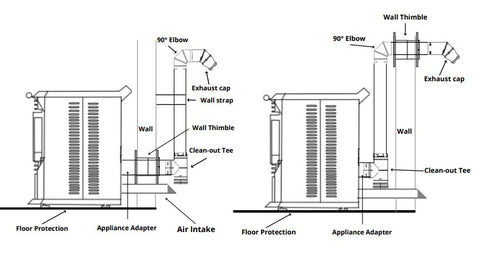5 Advantages of Pellet Stoves Over Wood Stoves
5 ADVANTAGES PELLET STOVES HAVE OVER TRADITIONAL WOOD STOVES
If you're looking for a way to save money on your heating bill, a wood stove may not be the best choice. Pellet stoves are more efficient and easier to install than traditional wood stoves, so they might be worth it if you want to reduce your carbon footprint and lower your utility bills this winter. In this blog post, we will discuss 5 advantages of pellet stoves as well as some tips on where to find them! (Hint, its Comfortbilt.net)
1) PELLET STOVES ARE EASIER TO INSTALL, AND CAN BE INSTALLED IN A BASEMENT, OR GARAGE.
Pellet stoves can be directly vented, and do not require a full, above roof, vertical piping stack for exhaust. There is some drilling required but it's much simpler than installing wood-burning appliances such as fireplaces and furnaces, which do require a through-the-roof vent pipe. In the past, other types of stoves required a chimney that had to be installed outside. This meant an extra expense and time/effort for installation. But with pellet stoves, you can install them in your basement or garage without having to worry about venting it through an existing roof - saving both money and time!
The most common installation is the simple vertical installation with a cleanout tee for easy maintenance and cleaning of the venting.

2) PELLET STOVES USE LESS SPACE, AND HAVE SMALLER CLEARANCES THAN A WOOD STOVE.
Pellet stoves can be as small or large as you need. There is a wide range of pellet stoves available to the modern consumer, ranging from 9,000 BTU/hr all the way up to 50,000 BTU/hr heat output.
Also, wood stoves typically require 15 inches or more for clearances around and behind the stove. With a pellet stove, you can get much closer to a combustible wall. Usually 7 inches from a side wall, 2 inches from a rear wall, and 5 inches from the rear corners, when installing in the corner of a room.

3) PELLET STOVES ARE MORE EFFICIENT THAN WOOD STOVES.
Pellet stoves are more efficient than wood stoves. It’s a well-known fact that burning high quality wood pellets produces much less ash and soot than cord wood, which also reduces the need for cleaning and maintenance work in your home.
Fireplaces also waste a lot of heated room air that goes up the chimney, up to 300 cubic feet per minute in some cases.
Pellet stoves often have a minimum efficiency rating of around 70% which is good news for those who want to save on heating bills. Some pellet stove models even have up to an 85%, which can help you get the most out of your fuel and are great options if you're looking to make your home as energy efficient as possible.
4) MODERN PELLET STOVES HAVE TEMPERATURE CONTROL SETTINGS SO YOU DON'T NEED TO WORRY ABOUT
The modern pellet stove has a variety of temperature control settings that allow you to heat the house exactly how you want it. You won't have to worry about overheating the house and wasting fuel. overheating your home and wasting fuel in the process!
With a traditional wood stove, there was very little in the way of temperature controls. Unless you wanted to babysit your firewood and make sure it didn't go out while trying not to let it get too hot, then cool off -- all depending on what kind of mood you were feeling that day--you had no choice but put up with whatever temperatures came along. But if these extremes are bothersome or uncomfortable for any particular reason (like an older person who doesn't want their house getting too cold), having pellets around is definitely appealing: they have much more control over precisely where they would like the room's comfort level to be at any given time.
5) YOU CAN GET A TAX CREDIT FOR INSTALLING A PELLET STOVE IF YOU LIVE IN CERTAIN AREAS. (CHECK WITH YOUR LOCAL GOVERNMENT)
Effective January 1st, 2021, a new Wood and Pellet Heater Investment Tax Credit came into effect for qualifying purchases completed on or after that date, through December 31, 2023. Found under section 25(D) of the tax code, this new credit covers 26 percent of the purchase and installation costs (with no cap or lifetime limit) for tax years 2021 and 2022; moving down to 22 percent of purchase and installation costs in 2023.
To qualify, the stove or insert must burn biomass as a fuel, heat air or water, and be at least 75 percent efficient per the higher heating value of the fuel. Installations at primary or secondary residencies can be claimed, and both the purchase and installation costs (venting and related materials, onsite labor) can be included in your total cost. Visit the rebates and credits page for more information and to get your tax certificate for qualifying purchases.
Many areas also have ongoing wood stove changeout and incentive programs. A wood stove changeout program is a voluntary program initiated at the local, state or regional level that provides eligible communities incentives to positively impact air quality. Residents of participating communities can receive rebates, low/no interest loans and/or discounts to replace their old appliances, with newer, more efficient wood or pellet stoves and fireplaces.
If you're still on the fence about installing a pellet stove, we encourage you to contact us. Our team of experts are here to answer any questions or concerns that may be holding you back from making this important decision for your home and family. We can help guide you through each step so that when it's time to purchase one, all of your needs will have been met with an expertly-designed system that meets every safety requirement and has been proven highly efficient over decades in use. You'll also find out how much money is available in tax credits if you live in certain areas which makes installation even more worthwhile! Contact our office today!


Leave a comment